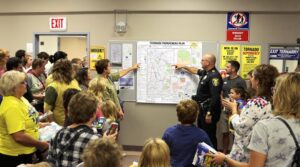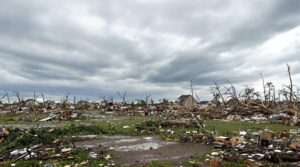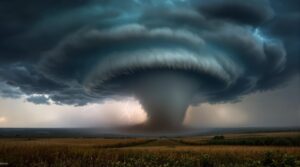EF5 tornadoes represent nature's most catastrophic atmospheric events, producing winds exceeding 200 mph and comprising less than 1% of recorded U.S. tornadoes. These phenomena cause complete structural failure of well-constructed buildings, strip bark from trees, and scour asphalt from roads. Debris transport extends up to 144 km at altitudes of 5.5-6.5 km. Safety measures include FEMA-certified underground shelters and vigilant monitoring of significant weather signs. The following analysis examines essential survival strategies and recovery protocols.
Key Takeaways
- EF5 tornadoes are the most violent category, with wind speeds exceeding 200 mph and causing complete destruction of well-constructed buildings.
- These catastrophic storms occur in less than 1% of U.S. tornado cases but caused 454 confirmed fatalities between 2007-2017.
- Critical warning signs include rotating wall clouds, dark green skies, severe thunderstorms with large hail, and hook echoes on radar.
- Underground shelters and FEMA-certified above-ground safe rooms provide the best protection against EF5 tornado damage.
- EF5 winds can strip bark from trees, scour asphalt from roads, and throw vehicles up to 25 kilometers from their origin.
Understanding EF5 Tornado Classifications
While tornadoes are classified on a scale from EF0 to EF5, the EF5 designation represents the most catastrophic category, characterized by wind speeds exceeding 200 mph and resulting in incredible structural devastation.
The tornado classification criteria for EF5 events involve thorough analysis of damage indicators, with these rare phenomena constituting less than 1% of all recorded tornadoes in the United States. The Enhanced Fujita Scale was publicly unveiled in 2006 by the National Weather Service as a more precise assessment tool.
EF5 characteristics include the complete destruction of well-constructed buildings, with structures often leveled to their foundations. These tornadoes exhibit the capacity to lift and project large vehicles significant distances, while simultaneously scouring landscapes and completely debarking trees.
The Enhanced Fujita Scale, implemented in 2007, utilizes 28 damage indicators and their corresponding degrees of damage to assess tornado intensity. Historical F5 tornadoes maintain their original classifications, though their estimated wind speeds have been adjusted to align with current meteorological standards and assessment methods.
The Raw Power of 200+ MPH Winds
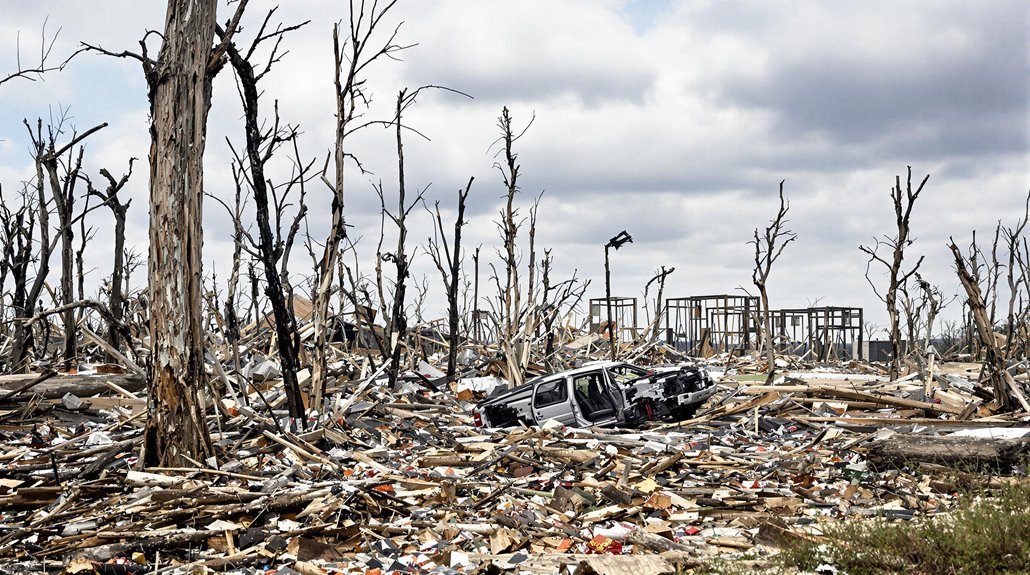
The atmospheric forces required to generate wind speeds exceeding 200 mph manifest in the most violent tornadic circulation systems known to meteorology.
These extreme weather phenomena demonstrate unprecedented tornado wind dynamics, capable of creating catastrophic destruction through both horizontal and vertical force components.
Key characteristics of EF5 tornado wind forces include:
- Capability to lift vehicles weighing several tons and transform them into high-velocity projectiles
- Sufficient energy to completely obliterate reinforced structures
- Vertical uplift strong enough to suspend heavy debris hundreds of feet in the atmosphere
- Sustained wind velocities that can strip bark from trees and scour asphalt from roadways
- Ability to carry lightweight objects for distances exceeding several miles
The immense power of these winds creates damage patterns that serve as critical indicators for post-storm analysis.
Between 2007 and 2017, these devastating storms resulted in 454 confirmed fatalities across the United States.
Damage assessment teams utilize these patterns, along with 28 specific damage indicators, to verify wind speeds and classify tornadic events within the Enhanced Fujita Scale framework.
Devastating Impact on Buildings and Infrastructure
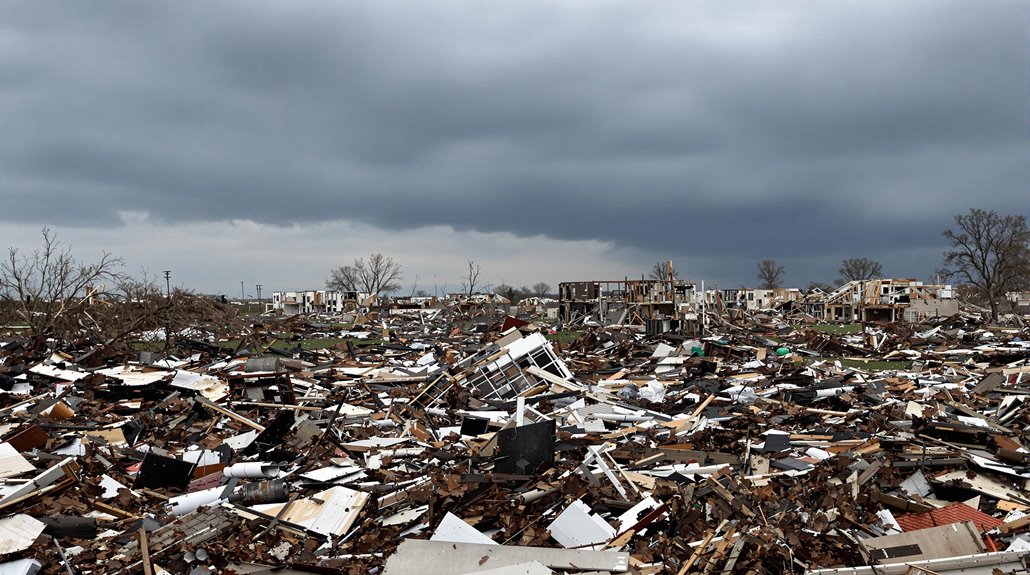
Nearly every structural component of buildings faces catastrophic failure when subjected to EF5 tornado wind forces exceeding 200 mph, resulting in extensive destruction of both commercial and residential infrastructure.
These violent vortices generate intense vertical lift forces capable of compromising even robust structural reinforcement techniques, often causing permanent deformation in multi-story buildings and complete obliteration of shopping complexes.
The integrity of tornado building materials greatly influences structural survival rates. While traditional construction prioritizes gravity load resistance, EF5 tornadic forces create complex stress patterns that can peel away roofs and transform ordinary objects into high-velocity projectiles.
Current damage assessment methods reveal that most tornadoes in the Great Plains region have caused catastrophic structural failures during peak tornado season.
Post-2015 model building codes now mandate specialized storm shelters in tornado-prone regions, acknowledging that conventional materials often prove insufficient.
Engineering assessments utilize 28 distinct damage indicators to evaluate structural failures, though precise wind speed determination remains challenging even for experienced meteorologists and wind engineers.
Vehicle and Debris Displacement Patterns
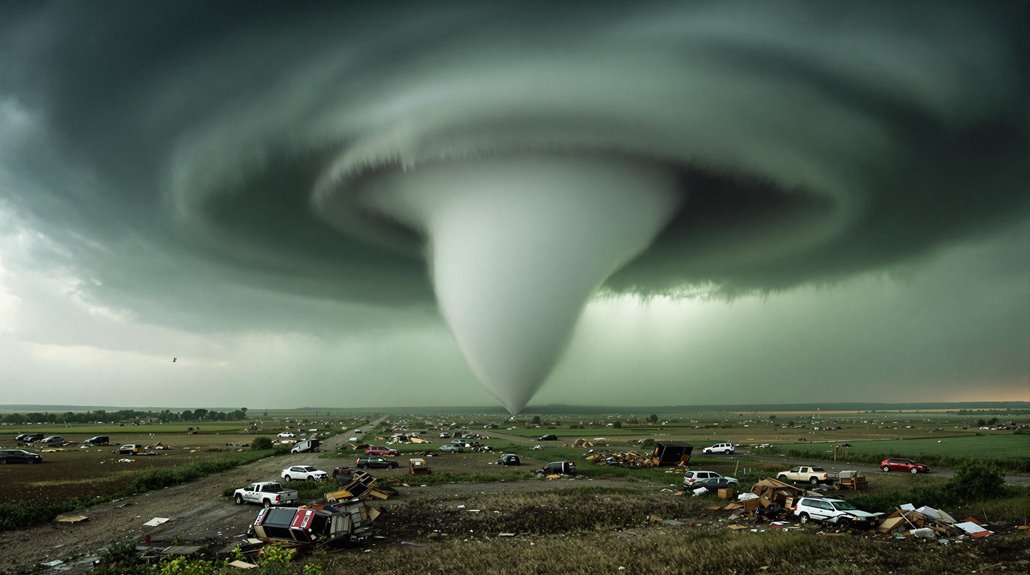
Studies examining vehicle displacement patterns reveal distinct correlations between tornado intensity and vehicular movement, with EF5 tornadoes displacing 69% of vehicles and tipping 31% within their damage paths.
Analysis shows progressive increases in displacement rates from EF0 through EF5 classifications, with critical thresholds observed between F2 and F3 wind speeds. At EF0 wind speeds, only 10% moved, showing minimal displacement risk in weaker tornadoes.
Vehicle types and environmental conditions greatly influence displacement patterns, while debris travel exhibits complex trajectories governed by atmospheric dynamics.
Research indicates that EF4 and EF5 tornadoes can generate remarkable debris displacement:
- Heavy debris typically falls within 25 km of origin
- Light debris can travel up to 144 km horizontally
- Debris reaches altitudes of 5.5-6.5 km above ground level
- Transport times average one hour from 3 km altitude
- Maximum recorded heavy object transport distance: 107 km
These patterns demonstrate the extraordinary force of EF5 tornadoes, where wind speeds exceeding 200 mph can displace even anchored concrete structures and heavy vehicles.
Key Differences Between EF Scale Ratings
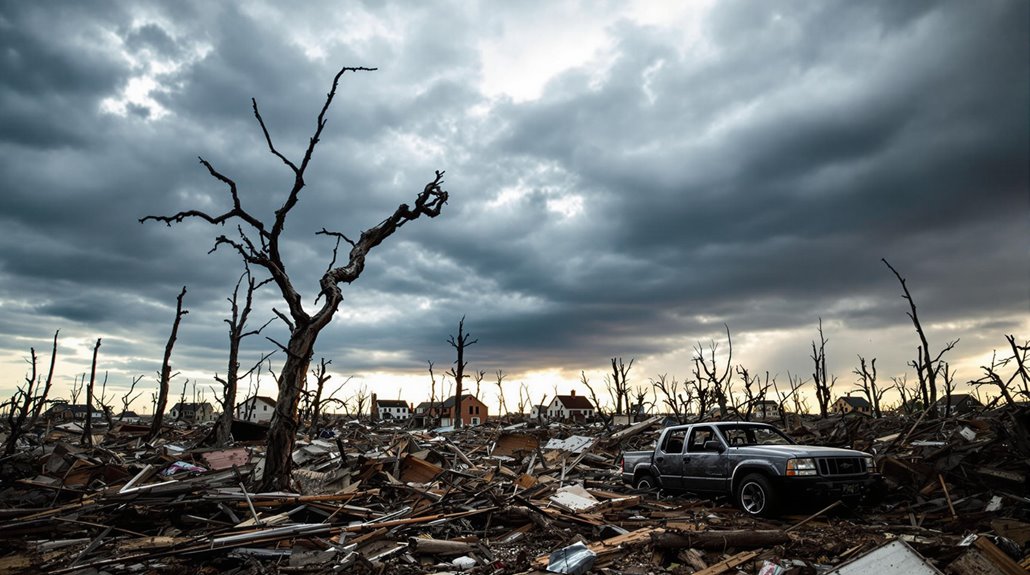
The Enhanced Fujita Scale utilizes standardized wind speed classifications that range from EF0 to EF5, with precise velocity thresholds established for each rating category.
Damage evidence assessment under the EF Scale incorporates 28 distinct damage indicators across various structure types and vegetation patterns, enabling more accurate intensity determinations than its predecessor. The highest category, EF5, demonstrates catastrophic damage with wind speeds exceeding 200 mph.
The systematic evaluation of structural failure modes, debris patterns, and environmental modifications provides empirical support for wind speed estimations within each EF rating category.
Wind Speed Classifications
Wind speed classifications within the Enhanced Fujita (EF) Scale establish distinct categories ranging from EF0 to EF5, with each level representing progressively more intense tornadic activity.
The scale utilizes precise wind speed measurements and damage assessment techniques to categorize tornado intensity effects:
- Weak Tornadoes (EF0/EF1): Wind speeds of 65-110 mph, causing light to moderate damage
- Moderate Tornadoes (EF2): Wind speeds of 111-135 mph, inflicting considerable structural damage
- Severe Tornadoes (EF3): Wind speeds of 136-165 mph, capable of uprooting trees
- Violent Tornadoes (EF4): Wind speeds of 166-200 mph, devastating most residential structures
- Incredible Tornadoes (EF5): Wind speeds exceeding 200 mph, capable of stripping bark from trees
This classification system enables meteorologists and researchers to systematically analyze tornado events and assess their destructive potential through standardized criteria.
Damage Evidence Assessment
Identifying key differences between EF-scale tornado ratings requires systematic analysis of specific damage indicators and structural failure patterns. The most critical distinction emerges between EF4 and EF5 classifications during damage assessment, particularly in the evaluation of well-built structures.
While EF4 tornadoes cause severe structural damage, reducing homes to debris piles on their foundations, EF5 events demonstrate complete obliteration of well-anchored buildings with minimal recognizable debris remaining.
Evidence evaluation utilizes 28 standardized damage indicators, examined through both aerial imagery and ground surveys. The assessment methodology considers construction quality and specific structural characteristics, with trained National Weather Service personnel analyzing degrees of damage for each indicator.
This systematic approach helps differentiate between varying intensity levels, though challenges persist due to regional variations in building practices.
Life-Saving Shelter Options During a Tornado
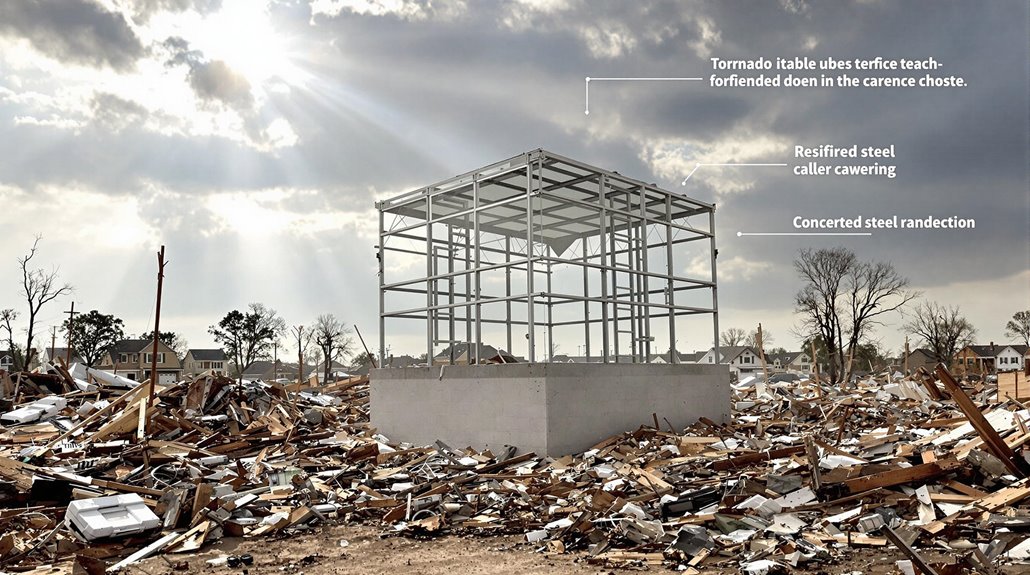
Securing appropriate shelter during an EF5 tornado requires careful consideration of both underground and above-ground protective structures that meet stringent safety specifications.
Modern shelter designs incorporate engineered safety features that provide maximum protection against extreme wind forces and debris impact. FEMA-certified structures must meet rigorous standards for structural integrity and occupant safety.
Essential shelter characteristics include:
- Reinforced steel construction with corrosion-resistant properties
- Secure anchoring systems integrated with concrete foundations
- Minimum space allocation of 5 square feet per occupant
- Strategic placement for rapid accessibility during warnings
- Weather-resistant sealing to prevent water infiltration
Both underground and above-ground installations offer viable protection when properly engineered.
Underground shelters typically integrate with existing structures like garages, while above-ground options can be installed in basements or first-floor locations.
All shelters must undergo systematic testing to verify their capacity to withstand the intense pressures and projectile impacts characteristic of EF5 tornadoes.
Critical Weather Warning Signs
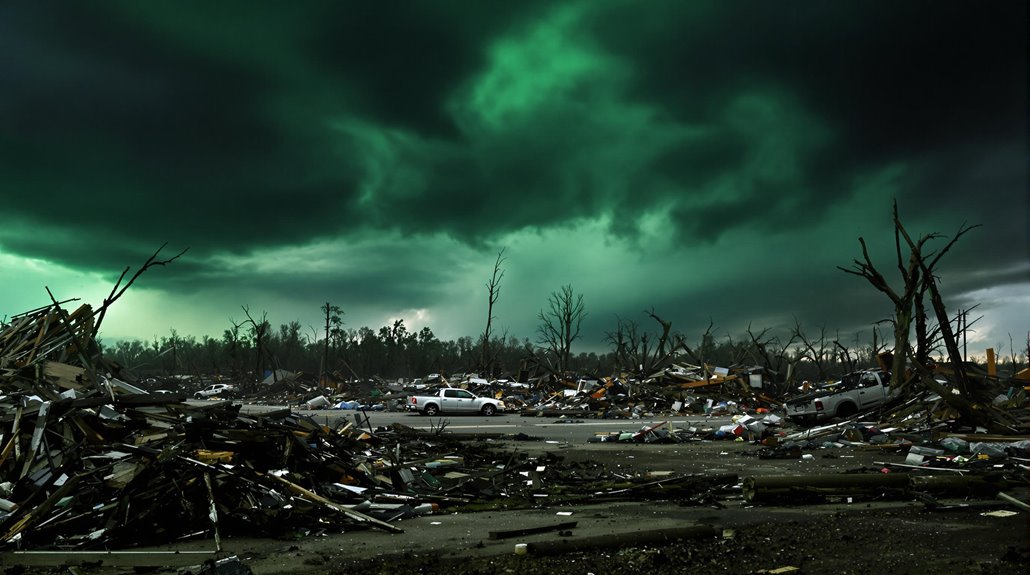
Recognizing the precursors of an EF5 tornado requires systematic observation of multiple atmospheric indicators that typically manifest during severe weather events.
Primary tornado formation indicators include rotating wall clouds, distinctive dark green skies caused by hail refraction, and the presence of severe thunderstorms characterized by intense rainfall and large hailstones.
Weather radar analysis provides critical data through multiple parameters. Hook echoes, typically observed on the southwestern edge of supercells, indicate strong updrafts conducive to tornadic development.
Storm Top Divergence measurements reveal updraft intensity, while Three Body Scatter Spikes signal significant hail formation. The identification of rotational couplets and mesocyclones through radar assists in predicting potential tornado formation.
Environmental conditions such as high humidity, coupled with auditory cues like train-like roaring and visual signs including airborne debris, serve as immediate warning indicators.
Sudden wind directional changes and outflow boundaries further enhance the probability of tornado development.
Essential Emergency Preparedness Steps
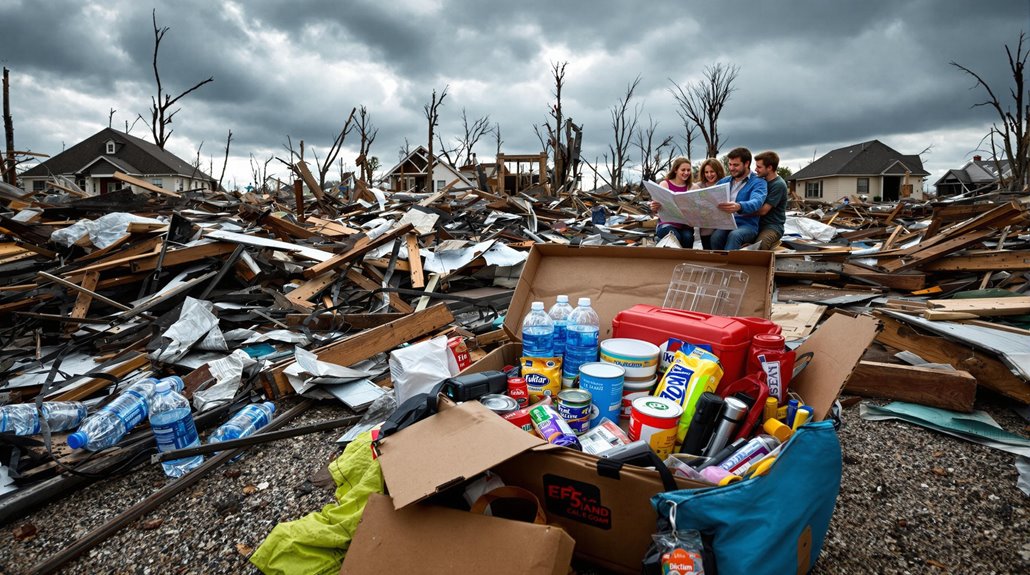
Effective tornado preparation requires establishing three fundamental components for maximum survival probability.
A complete emergency supply kit serves as the foundation, containing essential provisions for sustaining life during and after the event.
Implementation of a detailed family action plan, coupled with thorough knowledge of local warning systems, creates an integrated preparedness framework that maximizes response effectiveness during tornado emergencies.
Build Emergency Supply Kit
Building a thorough emergency supply kit stands as a critical foundation for EF5 tornado preparedness, requiring careful attention to essential provisions that sustain life and safety during the aftermath.
A detailed emergency supplies checklist encompasses multiple categories of survival necessities. When implementing kit assembly tips, prioritize these fundamental components:
- Water reserves of one gallon per person daily for 72 hours minimum
- Non-perishable food supplies with manual can opener
- First aid materials and prescription medications
- Battery-operated communication devices and NOAA Weather Radio
- Emergency shelter materials including plastic sheeting and blankets
The kit should be supplemented with sanitation supplies, important documents in waterproof storage, basic tools, and specific provisions for medical needs, infants, or pets.
Regular maintenance guarantees all components remain viable and unexpired.
Create Family Action Plan
When faced with the catastrophic potential of EF5 tornadoes, a methodically structured family action plan serves as the operational framework for household emergency response protocols. The plan necessitates systematic identification of local hazards, establishment of communication protocols, and designation of secure assembly points both within and outside the impact zone.
Implementation requires delineation of specific family roles, including responsibility assignments for utility deactivation, emergency supply management, and coordination with external emergency services.
Regular emergency drills, conducted biannually, guarantee operational readiness and facilitate muscle memory development for critical procedures. The protocol must incorporate provisions for special needs family members and domestic animals, while maintaining updated emergency contact repositories.
Periodic plan evaluation and modification guarantee sustained effectiveness through changing circumstances and evolving household demographics.
Know Local Warning Systems
Understanding local warning systems constitutes a critical foundation of tornado preparedness protocols, particularly for regions susceptible to EF5-intensity events. Local alert systems encompass multiple notification mechanisms designed to provide timely, potentially life-saving information.
The distinction between tornado watch vs warning remains fundamental: watches indicate favorable conditions for formation, while warnings confirm actual tornado presence through radar or visual confirmation.
Key components of warning systems include:
- Wireless Emergency Alerts (WEAs) delivering immediate mobile notifications
- Emergency management office broadcasts and community signage
- Local meteorological station updates and bulletins
- Weather service radio transmissions
- Mobile applications providing real-time radar data
These integrated alert mechanisms operate synchronously to maximize public safety through early detection and rapid dissemination of critical meteorological information, enabling residents to implement appropriate protective measures.
Notable EF5 Tornadoes Throughout History

The destructive power of EF5 tornadoes has left an indelible mark on human history through several catastrophic events that define the upper limits of tornado intensity.
The 1925 Tri-State Tornado stands as the deadliest single tornado in U.S. history, claiming 695 lives across Missouri, Illinois, and Indiana, demonstrating the historical significance of these atmospheric phenomena.
Notable events include the 1999 Bridge Creek-Moore Tornado, which recorded unprecedented wind speeds of 302 mph, and the 2013 El Reno Tornado, registering speeds exceeding 296 mph.
The Daulatpur-Saturia Tornado of 1989 in Bangladesh remains the deadliest globally, with approximately 1,300 fatalities.
Other significant events include the 1947 Monster Tornado that devastated Woodward, Oklahoma, and the 2011 Joplin Tornado, which resulted in 158 fatalities.
These events have shaped tornado survival strategies and advanced our understanding of extreme weather phenomena.
Regional Patterns and Risk Areas
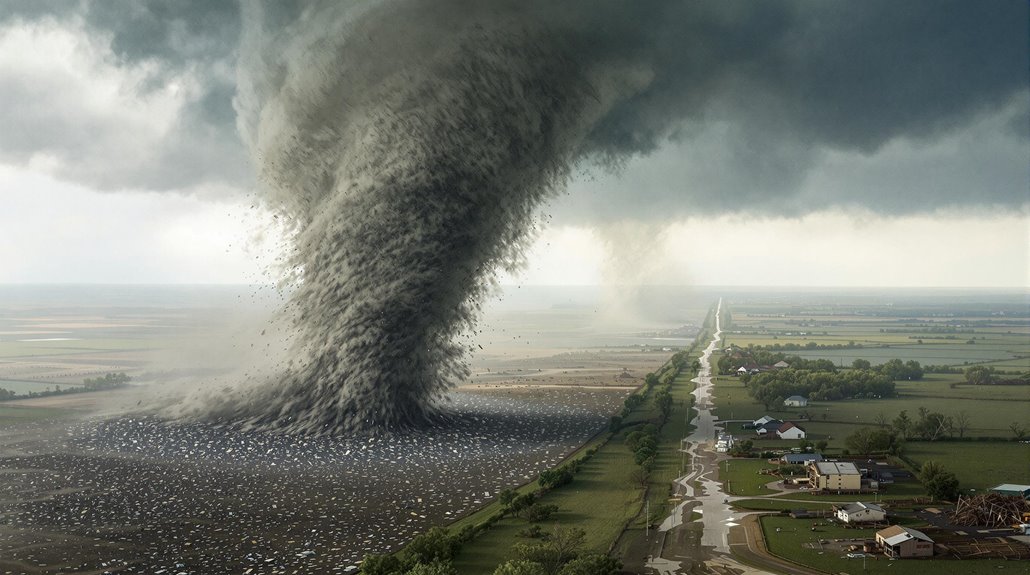
Regional tornado patterns exhibit significant geographic and temporal shifts, with contemporary data revealing an eastward migration of the traditional Tornado Alley.
Analysis of tornado geography from 1951-2020 demonstrates a 12% increase in eastern U.S. tornado activity, while western regions experienced a 25% decline. This shift has redefined high-risk zones, with Mississippi, Louisiana, and Alabama emerging as contemporary hotspots.
Key characteristics of regional tornado distribution include:
- Oklahoma, Iowa, Kansas, and Texas maintain the highest frequency of EF5 tornadoes since 1950
- Southeastern states face increasing tornado risk, particularly for violent events
- Formation patterns typically align with effective boundary positions
- Most EF3-EF5 tornadoes occur 50+ miles east-southeast of boundary intersection points
- Seasonal trends indicate increased formation during colder weather periods
The spatial distribution emphasizes the critical role of mesoscale analysis and boundary interactions in tornado development, particularly for the most violent classifications.
Structural Engineering Challenges
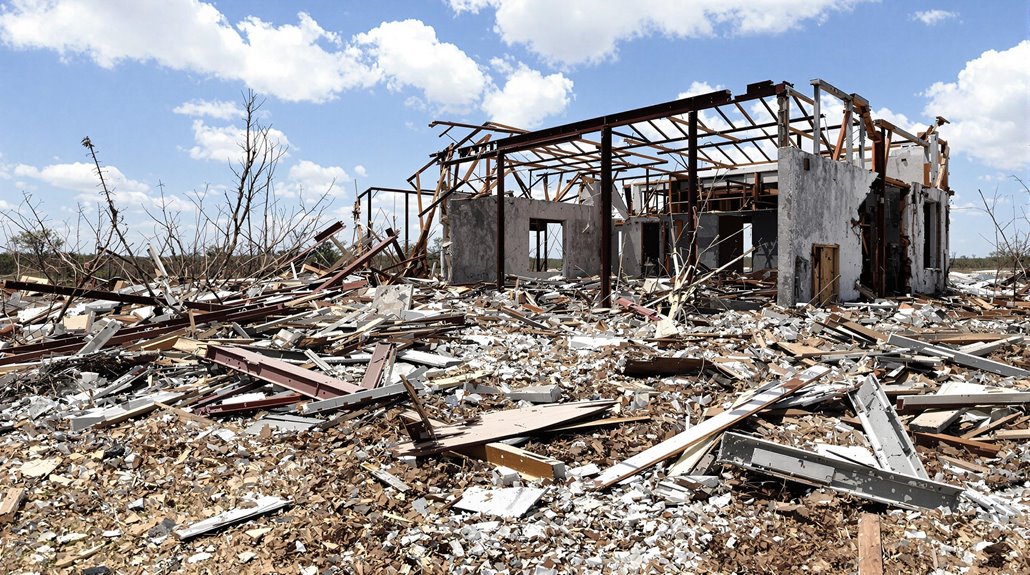
Structural engineering for EF5-rated tornadoes presents formidable technical challenges that extend beyond conventional wind-resistant design parameters. The primary difficulties lie in creating continuous load paths from roof to foundation while addressing extreme wind forces that exceed typical building code requirements.
Current standards, including the 2015 IBC, mandate minimum wind design speeds of 115 mph, though tornado preparedness for critical structures demands resistance to 250 mph winds.
Key factors affecting structural resilience include inadequate connections between building members, non-compliant construction practices, and economic constraints limiting widespread implementation of tornado-resistant designs.
The 2022 ASCE 7 guidelines have introduced specific requirements for critical and high-occupancy buildings, while ICC 500 standards dictate shelter specifications for debris impact resistance.
Essential engineering considerations encompass proper truss connections, hurricane clips, anchor bolts, and through-bolt applications. These elements must work in concert to create structures capable of withstanding the extreme forces associated with EF5 tornadoes.
Recovery and Rebuilding After an EF5
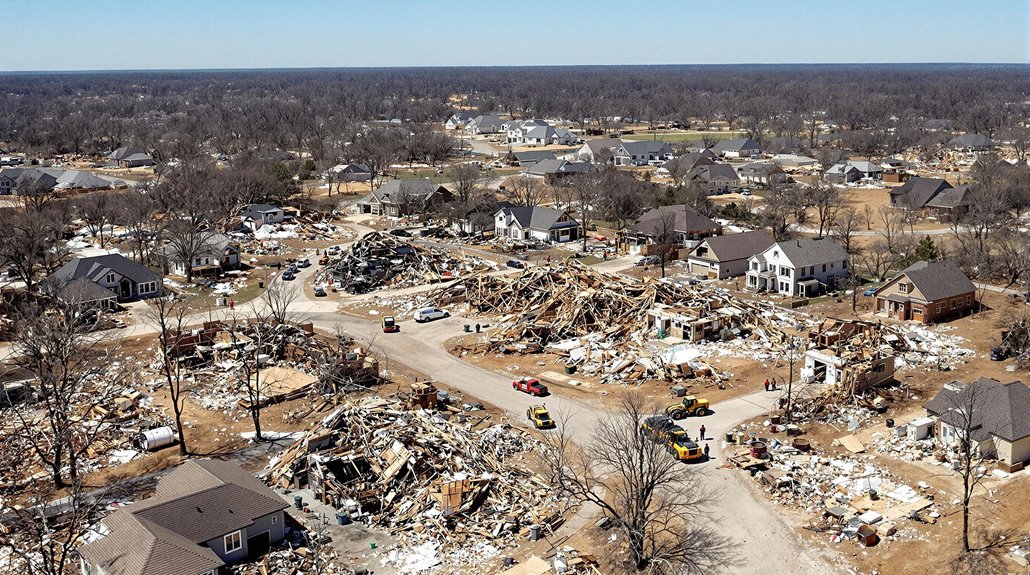
Thorough recovery and rebuilding efforts following an EF5 tornado typically unfold across multiple phases, with initial damage assessments requiring 1-2 weeks and complete restoration extending several months to years.
Insurance claims processing and federal aid coordination often present considerable financial barriers, particularly affecting low-income residents. Communities demonstrating strong community resilience, like Moore, Oklahoma, and Joplin, Missouri, have successfully implemented enhanced building codes that proved effective in subsequent storms.
Key components of post-EF5 recovery include:
- Initial structural assessment and damage documentation
- Insurance claims processing and federal aid application
- Implementation of upgraded building codes
- Major structural repairs and reconstruction
- Long-term infrastructure rehabilitation
The reconstruction phase typically requires 1-6 months for major repairs, though complete community restoration can extend considerably longer.
Success depends heavily on coordinated federal assistance, insurance accessibility, and systematic implementation of improved building standards to enhance structural resilience against future tornado events.
The Benefits Of Consulting A Public Adjuster

In the aftermath of an EF5 tornado, licensed public adjusters provide critical expertise in managing complex insurance claims and ensuring thorough damage assessments.
Their professional oversight streamlines the claims process through meticulous documentation, policy interpretation, and strategic representation of the policyholder's interests.
Statistical evidence indicates that public adjuster involvement typically results in markedly higher claim settlements, with documented increases averaging 574% compared to self-managed claims.
Early involvement of certified public adjusters is crucial for maximizing settlement outcomes and preventing potential complications in the claims process.
Expertise In Insurance Claims
Maneuvering complex insurance claims after an EF5 tornado requires specialized expertise that public adjusters can provide through their thorough understanding of policy interpretation, damage assessment protocols, and claims negotiation methodology.
These insurance claim strategies encompass extensive documentation, detailed damage assessments, and strategic negotiations with insurers. Public adjuster roles focus on maximizing claim settlements while alleviating policyholder stress during the recovery process.
- Professional analysis of insurance policies to identify all applicable coverage
- Systematic documentation of structural, content, and business interruption losses
- Implementation of proven negotiation techniques with insurance carriers
- Development of detailed damage inventories and cost assessments
- Application of industry-standard valuation methods for accurate settlement calculations
Their expertise in policy interpretation and claims management helps guarantee policyholders receive fair compensation for tornado-related damages while maintaining compliance with insurance regulations and documentation requirements. Operating on a contingency fee basis, public adjusters typically charge 5-20% of the final settlement amount while delivering more favorable claim outcomes.
Objective Damage Assessment
Professional damage assessment through a public adjuster provides property owners with an impartial, data-driven evaluation of tornado-related destruction that adheres to established industry protocols. Utilizing advanced damage assessment techniques, these experts conduct thorough analyses to document structural failures, content losses, and ancillary damages.
| Assessment Component | Technical Analysis | Insurance Claim Strategies |
|---|---|---|
| Documentation | Photographic Evidence | Detailed Inventory Reports |
| Evaluation Methods | Scientific Measurement | Category Classification |
| Settlement Process | Data-Driven Analysis | Strategic Negotiation |
Their expertise facilitates effective insurance claim strategies through extensive documentation, scientific measurement protocols, and strategic negotiations with insurers. This systematic approach minimizes claim disputes, addresses potential underpayment issues, and guarantees accurate categorization of tornado damage severity, ultimately maximizing settlement outcomes while maintaining regulatory compliance throughout the claims process. Unlike insurance adjusters who represent insurance companies, public adjuster commissions are based on the final settlement amount, ensuring their interests align directly with the property owner's financial recovery.
Streamlined Claim Process
Consulting a public adjuster greatly enhances the insurance claim process for property owners affected by EF5 tornado damage. Through professional claim strategy and insurance advocacy, public adjusters streamline documentation procedures while guaranteeing thorough policy compliance.
Their expertise in maneuvering complex insurance terminology and requirements greatly reduces processing time and policyholder stress.
- Provides thorough analysis of insurance policies to maximize coverage potential
- Implements systematic documentation of structural and property damage
- Manages all communication and negotiations with insurance carriers
- Guarantees compliance with policy conditions and filing deadlines
- Develops data-driven strategies for ideal claim resolution
This systematic approach by public adjusters allows property owners to focus on recovery while maintaining technical accuracy throughout the claims process.
Their professional oversight helps prevent claim denials and underpayment through meticulous attention to procedural requirements and documentation standards.
With settlement rates typically 15-30% higher than self-managed claims, public adjusters provide significant financial value while alleviating the stress of complex insurance procedures.
Higher Claim Payouts & Settlements
The engagement of a public adjuster yields quantifiably superior financial outcomes for EF5 tornado damage claims. Through thorough damage assessment protocols and strategic claim negotiation strategies, these licensed professionals systematically identify both apparent and latent structural damages, maximizing insurance settlements through empirical documentation and forensic analysis.
| Assessment Component | Standard Claim | Public Adjuster Claim |
|---|---|---|
| Hidden Damage Detection | Limited | Thorough |
| Professional Evaluation | Basic | Advanced Technical |
| Settlement Optimization | Minimal | Maximized |
Public adjusters employ specialized methodologies in damage quantification, utilizing forensic accountants and structural engineers to substantiate claims. Their expertise in insurance policy interpretation and negotiation tactics typically results in considerably higher settlement amounts, while eliminating policyholder out-of-pocket expenses through contingency-based compensation structures. This systematic approach guarantees premier financial recovery for catastrophic EF5 tornado damage. Public insurance adjusters work exclusively for homeowners rather than insurance companies, ensuring unbiased advocacy throughout the claims process.
About The Public Claims Adjusters Network (PCAN)
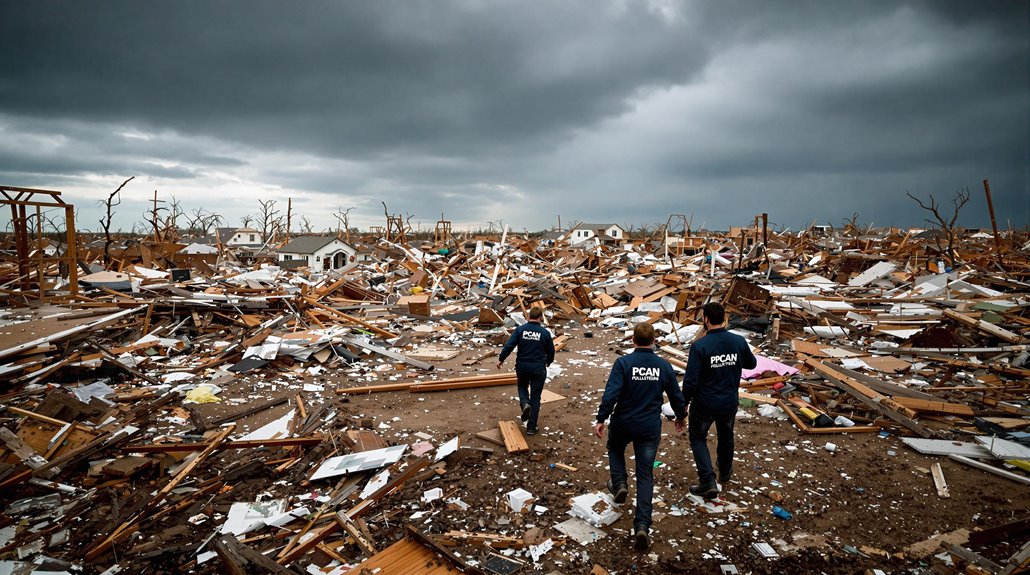
Operating globally across all 50 states and five continents, Public Claims Adjusters Network (PCAN) functions as an independent organization of licensed insurance adjusters who advocate exclusively for policyholders during insurance claims processes.
Insurance claim advocacy through PCAN guarantees objective assessment, thorough policy analysis, and maximized settlement outcomes.
Public adjuster benefits include:
- Professional analysis of insurance policy coverage and limitations
- Expert damage assessment and claim value calculations
- Strategic negotiation with insurance companies for ideal settlements
- Complete management of documentation and communication processes
- Ongoing support throughout the entire claims procedure
PCAN's expertise encompasses detailed understanding of repair scopes, construction costs, business interruption assessments, and long-term property value implications.
Their adjusters maintain professional certifications and adhere to industry standards while providing independent evaluations distinct from insurance company adjusters.
This specialized knowledge enables PCAN to secure favorable outcomes while alleviating the complexity of the claims process for policyholders.
Frequently Asked Questions
Can Pets Sense an Approaching EF5 Tornado Before Humans Can?
How remarkable are animal instincts? Scientific evidence confirms that dogs can detect approaching tornadoes through barometric pressure changes, providing natural tornado warnings before human awareness of impending danger.
How Long Does It Typically Take for Vegetation to Regrow After EF5 Damage?
Vegetation recovery following tornado aftermath typically spans multiple years, with complete regeneration taking 3-5 years. Recovery rates vary considerably based on initial damage severity and ecosystem type.
What Percentage of EF5 Tornado Victims Experience Long-Term Psychological Trauma?
Beyond physical devastation, studies indicate 12.63% to 26.74% of survivors experience long-term psychological trauma, with heightened prevalence among children, women, and socioeconomically disadvantaged populations during trauma recovery phases.
Do EF5 Tornadoes Create Their Own Magnetic Fields During Formation?
Current scientific research shows no evidence that tornadoes generate their own magnetic fields during formation. Tornado development is primarily driven by atmospheric conditions rather than electromagnetic processes.
Can Underground Bunkers Withstand Direct Hits From Falling Trees During EF5 Tornadoes?
Properly engineered underground bunker designs, with reinforced concrete construction and adequate depth, can effectively withstand direct tree impacts, as their structural integrity exceeds the force generated by falling vegetation masses.
References
- https://rainbowrestores.com/blog/what-is-the-fujita-scale
- https://www.lincolnu.edu/police/safety-resources/tornado-safety.html
- https://www.worldvision.org/disaster-relief-news-stories/tornado-facts
- https://www.dnr.sc.gov/climate/sco/Education/facts/torado.pdf
- https://www.weather.gov/mkx/taw-tornado_classification_safety
- https://en.wikipedia.org/wiki/EF4
- https://www.nssl.noaa.gov/education/svrwx101/tornadoes/
- https://survive-a-storm.com/blog/tornado-intensity-fujita-f5-or-ef5/
- https://survive-a-storm.com/blog/ef5-tornadoes/
- https://www.factsjustforkids.com/weather-facts/ef5-tornado/

